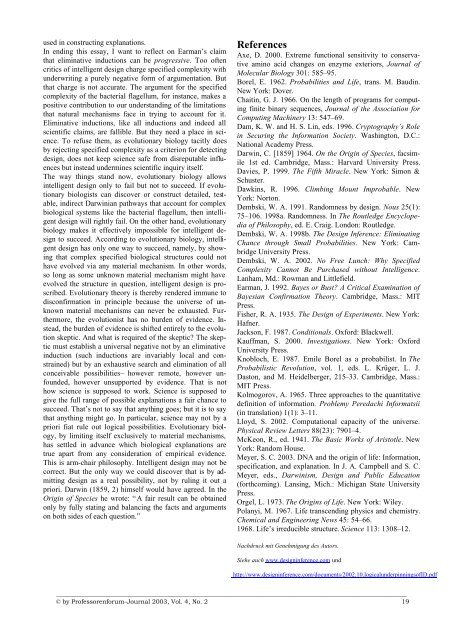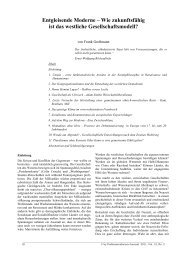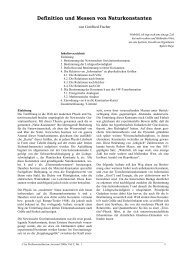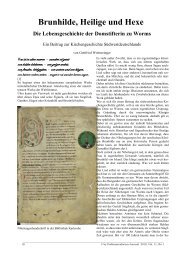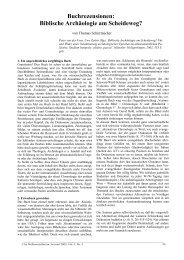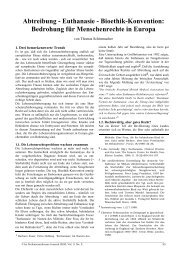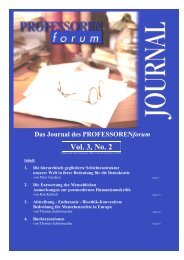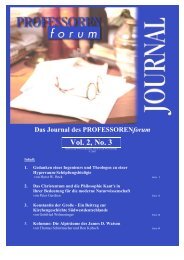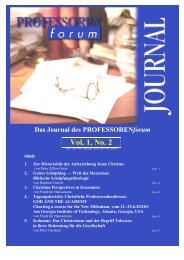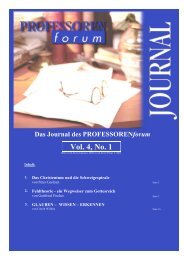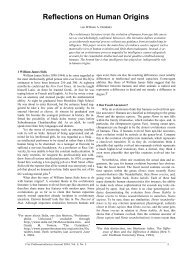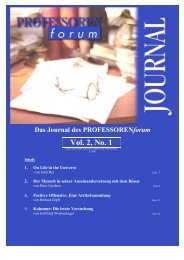Vol. 1, No. 1 Vol. 4, No. 2 - Professorenforum
Vol. 1, No. 1 Vol. 4, No. 2 - Professorenforum
Vol. 1, No. 1 Vol. 4, No. 2 - Professorenforum
Sie wollen auch ein ePaper? Erhöhen Sie die Reichweite Ihrer Titel.
YUMPU macht aus Druck-PDFs automatisch weboptimierte ePaper, die Google liebt.
used in constructing explanations.<br />
In ending this essay, I want to reflect on Earman’s claim<br />
that eliminative inductions can be progressive. Too often<br />
critics of intelligent design charge specified complexity with<br />
underwriting a purely negative form of argumentation. But<br />
that charge is not accurate. The argument for the specified<br />
complexity of the bacterial flagellum, for instance, makes a<br />
positive contribution to our understanding of the limitations<br />
that natural mechanisms face in trying to account for it.<br />
Eliminative inductions, like all inductions and indeed all<br />
scientific claims, are fallible. But they need a place in science.<br />
To refuse them, as evolutionary biology tacitly does<br />
by rejecting specified complexity as a criterion for detecting<br />
design, does not keep science safe from disreputable influences<br />
but instead undermines scientific inquiry itself.<br />
The way things stand now, evolutionary biology allows<br />
intelligent design only to fail but not to succeed. If evolutionary<br />
biologists can discover or construct detailed, testable,<br />
indirect Darwinian pathways that account for complex<br />
biological systems like the bacterial flagellum, then intelligent<br />
design will rightly fail. On the other hand, evolutionary<br />
biology makes it effectively impossible for intelligent design<br />
to succeed. According to evolutionary biology, intelligent<br />
design has only one way to succeed, namely, by showing<br />
that complex specified biological structures could not<br />
have evolved via any material mechanism. In other words,<br />
so long as some unknown material mechanism might have<br />
evolved the structure in question, intelligent design is proscribed.<br />
Evolutionary theory is thereby rendered immune to<br />
disconfirmation in principle because the universe of unknown<br />
material mechanisms can never be exhausted. Furthermore,<br />
the evolutionist has no burden of evidence. Instead,<br />
the burden of evidence is shifted entirely to the evolution<br />
skeptic. And what is required of the skeptic? The skeptic<br />
must establish a universal negative not by an eliminative<br />
induction (such inductions are invariably local and constrained)<br />
but by an exhaustive search and elimination of all<br />
conceivable possibilities— however remote, however unfounded,<br />
however unsupported by evidence. That is not<br />
how science is supposed to work. Science is supposed to<br />
give the full range of possible explanations a fair chance to<br />
succeed. That’s not to say that anything goes; but it is to say<br />
that anything might go. In particular, science may not by a<br />
priori fiat rule out logical possibilities. Evolutionary biology,<br />
by limiting itself exclusively to material mechanisms,<br />
has settled in advance which biological explanations are<br />
true apart from any consideration of empirical evidence.<br />
This is arm-chair philosophy. Intelligent design may not be<br />
correct. But the only way we could discover that is by admitting<br />
design as a real possibility, not by ruling it out a<br />
priori. Darwin (1859, 2) himself would have agreed. In the<br />
Origin of Species he wrote: “A fair result can be obtained<br />
only by fully stating and balancing the facts and arguments<br />
on both sides of each question.”<br />
References<br />
Axe, D. 2000. Extreme functional sensitivity to conservative<br />
amino acid changes on enzyme exteriors, Journal of<br />
Molecular Biology 301: 585–95.<br />
Borel, E. 1962. Probabilities and Life, trans. M. Baudin.<br />
New York: Dover.<br />
Chaitin, G. J. 1966. On the length of programs for computing<br />
finite binary sequences, Journal of the Association for<br />
Computing Machinery 13: 547–69.<br />
Dam, K. W. and H. S. Lin, eds. 1996. Cryptography’s Role<br />
in Securing the Information Society. Washington, D.C.:<br />
National Academy Press.<br />
Darwin, C. [1859] 1964. On the Origin of Species, facsimile<br />
1st ed. Cambridge, Mass.: Harvard University Press.<br />
Davies, P. 1999. The Fifth Miracle. New York: Simon &<br />
Schuster.<br />
Dawkins, R. 1996. Climbing Mount Improbable. New<br />
York: <strong>No</strong>rton.<br />
Dembski, W. A. 1991. Randomness by design. <strong>No</strong>us 25(1):<br />
75–106. 1998a. Randomness. In The Routledge Encyclopedia<br />
of Philosophy, ed. E. Craig. London: Routledge.<br />
Dembski, W. A. 1998b. The Design Inference: Eliminating<br />
Chance through Small Probabilities. New York: Cambridge<br />
University Press.<br />
Dembski, W. A. 2002. <strong>No</strong> Free Lunch: Why Specified<br />
Complexity Cannot Be Purchased without Intelligence.<br />
Lanham, Md.: Rowman and Littlefield.<br />
Earman, J. 1992. Bayes or Bust? A Critical Examination of<br />
Bayesian Confirmation Theory. Cambridge, Mass.: MIT<br />
Press.<br />
Fisher, R. A. 1935. The Design of Experiments. New York:<br />
Hafner.<br />
Jackson, F. 1987. Conditionals. Oxford: Blackwell.<br />
Kauffman, S. 2000. Investigations. New York: Oxford<br />
University Press.<br />
Knobloch, E. 1987. Emile Borel as a probabilist. In The<br />
Probabilistic Revolution, vol. 1, eds. L. Krüger, L. J.<br />
Daston, and M. Heidelberger, 215–33. Cambridge, Mass.:<br />
MIT Press.<br />
Kolmogorov, A. 1965. Three approaches to the quantitative<br />
definition of information. Problemy Peredachi Informatsii<br />
(in translation) 1(1): 3–11.<br />
Lloyd, S. 2002. Computational capacity of the universe.<br />
Physical Review Letters 88(23): 7901–4.<br />
McKeon, R., ed. 1941. The Basic Works of Aristotle. New<br />
York: Random House.<br />
Meyer, S. C. 2003. DNA and the origin of life: Information,<br />
specification, and explanation. In J. A. Campbell and S. C.<br />
Meyer, eds., Darwinism, Design and Public Education<br />
(forthcoming). Lansing, Mich.: Michigan State University<br />
Press.<br />
Orgel, L. 1973. The Origins of Life. New York: Wiley.<br />
Polanyi, M. 1967. Life transcending physics and chemistry.<br />
Chemical and Engineering News 45: 54–66.<br />
1968. Life’s irreducible structure. Science 113: 1308–12.<br />
Nachdruck mit Genehmigung des Autors.<br />
Siehe auch www.designinference.com und<br />
http://www.designinference.com/documents/2002.10.logicalunderpinningsofID.pdf<br />
_________________________________________________________________________________________________________________<br />
© by <strong>Professorenforum</strong>-Journal 2003, <strong>Vol</strong>. 4, <strong>No</strong>. 2 19


